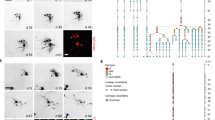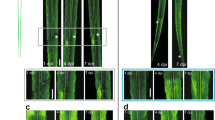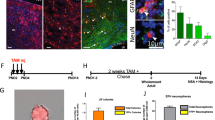Abstract
Adult neural stem cells (aNSCs) in zebrafish produce mature neurons throughout their entire life span in both the intact and regenerating brain. An understanding of the behavior of aNSCs in their intact niche and during regeneration in vivo should facilitate the identification of the molecular mechanisms controlling regeneration-specific cellular events. A greater understanding of the process in regeneration-competent species may enable regeneration to be achieved in regeneration-incompetent species, including humans. Here we describe a protocol for labeling and repetitive imaging of aNSCs in vivo. We label single aNSCs, allowing nonambiguous re-identification of single cells in repetitive imaging sessions using electroporation of a red-reporter plasmid in Tg(gfap:GFP)mi2001 transgenic fish expressing GFP in aNSCs. We image using two-photon microscopy through the thinned skull of anesthetized and immobilized fish. Our protocol allows imaging every 2 d for a period of up to 1 month. This methodology allowed the visualization of aNSC behavior in vivo in their natural niche, in contrast to previously available technologies, which rely on the imaging of either dissociated cells or tissue slices. We used this protocol to follow the mode of aNSC division, fate changes and cell death in both the intact and injured zebrafish telencephalon. This experimental setup can be widely used, with minimal prior experience, to assess key factors for processes that modulate aNSC behavior. A typical experiment with data analysis takes up to 1.5 months.
This is a preview of subscription content, access via your institution
Access options
Subscribe to this journal
Receive 12 print issues and online access
$259.00 per year
only $21.58 per issue
Buy this article
- Purchase on Springer Link
- Instant access to full article PDF
Prices may be subject to local taxes which are calculated during checkout







Similar content being viewed by others
References
Adolf, B. et al. Conserved and acquired features of adult neurogenesis in the zebrafish telencephalon. Dev. Biol. 295, 278–293 (2006).
Weiner, L. in Neural Stem Cells Vol. 438 Methods in Molecular Biology (ed. Weiner, Leslie P.) Ch. 1, 3–8 (Humana Press, 2008).
Ernst, A. et al. Neurogenesis in the striatum of the adult human brain. Cell 156, 1072–1083 (2014).
Spalding, K.L. et al. Dynamics of hippocampal neurogenesis in adult humans. Cell 153, 1219–1227 (2013).
Grandel, H., Kaslin, J., Ganz, J., Wenzel, I. & Brand, M. Neural stem cells and neurogenesis in the adult zebrafish brain: origin, proliferation dynamics, migration and cell fate. Dev. Biol. 295, 263–277 (2006).
Zupanc, G.K., Hinsch, K. & Gage, F.H. Proliferation, migration, neuronal differentiation, and long-term survival of new cells in the adult zebrafish brain. J. Comp. Neurol. 488, 290–319 (2005).
Altman, J. & Das, G.D. Post-natal origin of microneurones in the rat brain. Nature 207, 953–956 (1965).
Lois, C. & Alvarez-Buylla, A. Long-distance neuronal migration in the adult mammalian brain. Science 264, 1145–1148 (1994).
Doetsch, F., Caille, I., Lim, D.A., Garcia-Verdugo, J.M. & Alvarez-Buylla, A. Subventricular zone astrocytes are neural stem cells in the adult mammalian brain. Cell 97, 703–716 (1999).
Imayoshi, I. et al. Roles of continuous neurogenesis in the structural and functional integrity of the adult forebrain. Nat. Neurosci. 11, 1153–1161 (2008).
Gu, Y. et al. Optical controlling reveals time-dependent roles for adult-born dentate granule cells. Nat. Neurosci. 15, 1700–1706 (2012).
Nakashiba, T. et al. Young dentate granule cells mediate pattern separation, whereas old granule cells facilitate pattern completion. Cell 149, 188–201 (2012).
Kroehne, V., Freudenreich, D., Hans, S., Kaslin, J. & Brand, M. Regeneration of the adult zebrafish brain from neurogenic radial glia-type progenitors. Development 138, 4831–4841 (2011).
Kirkham, M., Hameed, L.S., Berg, Daniel, A., Wang, H. & Simon, A. Progenitor cell dynamics in the newt telencephalon during homeostasis and neuronal regeneration. Stem Cell Reports 2, 507–519 (2014).
Berg, D.A. et al. Efficient regeneration by activation of neurogenesis in homeostatically quiescent regions of the adult vertebrate brain. Development 137, 4127–4134 (2010).
Skaggs, K., Goldman, D. & Parent, J.M. Excitotoxic brain injury in adult zebrafish stimulates neurogenesis and long-distance neuronal integration. Glia 62, 2061–2079 (2014).
Rothenaigner, I. et al. Clonal analysis by distinct viral vectors identifies bona fide neural stem cells in the adult zebrafish telencephalon and characterizes their division properties and fate. Development 138, 1459–1469 (2011).
Calzolari, F. et al. Fast clonal expansion and limited neural stem cell self-renewal in the adult subependymal zone. Nat. Neurosci. 18, 490–492 (2015).
Encinas, J.M. et al. Division-coupled astrocytic differentiation and age-related depletion of neural stem cells in the adult hippocampus. Cell Stem Cell 8, 566–579 (2011).
Bonaguidi, M.A. et al. In vivo clonal analysis reveals self-renewing and multipotent adult neural stem cell characteristics. Cell 145, 1142–1155 (2011).
Alexandre, P., Reugels, A.M., Barker, D., Blanc, E. & Clarke, J.D. Neurons derive from the more apical daughter in asymmetric divisions in the zebrafish neural tube. Nat. Neurosci. 13, 673–679 (2010).
Dong, Z., Yang, N., Yeo, S.-Y., Chitnis, A. & Guo, S. Intralineage directional Notch signaling regulates self-renewal and differentiation of asymmetrically dividing radial glia. Neuron 74, 65–78 (2012).
Barbosa, J.S. et al. Live imaging of adult neural stem cell behavior in the intact and injured zebrafish brain. Science 348, 789–793 (2015).
Ganz, J. et al. Subdivisions of the adult zebrafish subpallium by molecular marker analysis. J. Comp. Neurol. 520, 633–655 (2012).
Grandel, H. & Brand, M. Comparative aspects of adult neural stem cell activity in vertebrates. Dev. Genes Evol. 223, 131–147 (2013).
Baumgart, E.V., Barbosa, J.S., Bally-Cuif, L., Gotz, M. & Ninkovic, J. Stab wound injury of the zebrafish telencephalon: a model for comparative analysis of reactive gliosis. Glia 60, 343–357 (2012).
März, M., Schmidt, R., Rastegar, S. & Strähle, U. Regenerative response following stab injury in the adult zebrafish telencephalon. Dev. Dyn. 240, 2221–2231 (2011).
Ayari, B., Elhachimi, K.H., Yanicostas, C., Landoulsi, A. & Soussi-Yanicostas, N. Prokineticin 2 expression is associated with neural repair of injured adult zebrafish telencephalon. J. Neurotrauma 27, 959–972 (2010).
Kishimoto, N., Shimizu, K. & Sawamoto, K. Neuronal regeneration in a zebrafish model of adult brain injury. Dis. Model. Mech. 5, 200–209 (2012).
März, M. et al. Heterogeneity in progenitor cell subtypes in the ventricular zone of the zebrafish adult telencephalon. Glia 58, 870–888 (2010).
Ganz, J., Kaslin, J., Hochmann, S., Freudenreich, D. & Brand, M. Heterogeneity and Fgf dependence of adult neural progenitors in the zebrafish telencephalon. Glia 58, 1345–1363 (2010).
Ninkovic, J., Mori, T. & Gotz, M. Distinct modes of neuron addition in adult mouse neurogenesis. J. Neurosci. 27, 10906–10911 (2007).
Fischer, R.S., Wu, Y., Kanchanawong, P., Shroff, H. & Waterman, C.M. Microscopy in 3D: a biologist's toolbox. Trends Cell Biol. 21, 682–691 (2011).
Helmchen, F. & Denk, W. Deep tissue two-photon microscopy. Nat. Meth. 2, 932–940 (2005).
Kelsh, R.N. et al. Zebrafish pigmentation mutations and the processes of neural crest development. Development 123, 369–389 (1996).
Dray, N. et al. Large-scale live imaging of adult neural stem cells in their endogenous niche. Development 142, 3592–3600 (2015).
White, R.M. et al. Transparent adult zebrafish as a tool for in vivo transplantation analysis. Cell Stem Cell 2, 183–189 (2008).
Xu, H.-T., Pan, F., Yang, G. & Gan, W.B. Choice of cranial window type for in vivo imaging affects dendritic spine turnover in the cortex. Nat. Neurosci. 10, 549–551 (2007).
Bernardos, R. & Raymond, P. GFAP transgenic zebrafish. Gene Expr. Patterns 6, 1007–1013 (2006).
Kizil, C. & Brand, M. Cerebroventricular microinjection (CVMI) into adult zebrafish brain is an efficient misexpression method for forebrain ventricular cells. PLoS ONE 6, e27395 (2011).
Huber, A.B. et al. Distinct roles for secreted semaphorin signaling in spinal motor axon guidance. Neuron 48, 949–964 (2005).
Xu, C., Volkery, S. & Siekmann, A.F. Intubation-based anesthesia for long-term time-lapse imaging of adult zebrafish. Nat. Protoc. 10, 2064–2073 (2015).
Westerfield,, M. The Zebrafish Book. A Guide for the Laboratory use of Zebrafish (Danio Rerio) 4th edn. (Univ. of Oregon Press, Eugene, 2000).
Park, H.C. et al. Analysis of upstream elements in the HuC promoter leads to the establishment of transgenic zebrafish with fluorescent neurons. Dev. Biol. 227, 279–293 (2000).
Mosimann, C. et al. Ubiquitous transgene expression and Cre-based recombination driven by the ubiquitin promoter in zebrafish. Development 138, 169–177 (2011).
Acknowledgements
We thank J. Fisher for critical reading of the manuscript. We also gratefully acknowledge funding to J.N. from the German Research Foundation (DFG) by the SFB 870 and SPP 'Integrative Analysis of Olfaction' grants; to M.G. from the DFG by the SFB 870, SYNERGY, SPP1757 'Functional Specializations of Neuroglia as Critical Determinants of Brain Activity', ICEMED Helmholtz Alliance and ERC ChroNeuroRepair: GA no. 340793 grants; and to J.S.B. from the Fundação para a Ciência e Tecnologia, Portugal (FCT). We obtained the plasmid ubi:Cherry (used in cytoplasmic localization) as a gift from Christian Mosimann (Institute of Molecular Life Sciences, University of Zurich, Zurich, Switzerland); we obtained the plasmid pCS-H2B-mRFP (used in nuclear localization) from Sean Megason (Department of Systems Biology, Harvard Medical School, Boston, MA).
Author information
Authors and Affiliations
Contributions
J.S.B. designed and performed live imaging experiments and wrote the manuscript; R.D.G. performed FACS experiments; M.G. designed experiments and wrote the manuscript; J.N. designed and supervised experiments and wrote the manuscript.
Corresponding author
Ethics declarations
Competing interests
The authors declare no competing financial interests.
Integrated supplementary information
Supplementary Figure 1 Effect of the animal genetic background and the skull thinning procedure on aNSCs proliferation and microglia reaction.
(a) Quantification by fluorescence activated cell sorting (FACS) of the number of proliferating NSCs (gfap:GFP+ and PCNA+), performed according to Barbosa et al 2015, in fish with the brassy or the wild type AB/EK background. Data are shown as mean ± SEM with symbols representing single animals. Mann-Whitney test was used for the statistical evaluation (n=5). (b) Quantification of the number of proliferating NSCs in fish of the brassy background without skull thinning procedure and 24h or 48h after thinning the skull. Data are shown as mean ± SEM with symbols representing single animals. Kruskal–Wallis multiple comparison test was used for the statistical evaluation (n=5). (c) to (f) Coronal hemi-sections of the zebrafish telencephalon, stained for 4C4, which labels microglia cells, 19h after injury (as described in Baumgart et al) (c), removal of the skull (d) or thinning of the skull (e) in the area above the telencephalon. Note the strong reaction of microglia after injury (c) and skull removal (d), compared to the situation after thinning of the skull (e) and in the intact brain (f). All the pictures were acquired using the same laser settings, for an appropriate comparison of 4C4 levels. Scale bars 50µm. Dotted line outlines telencephalic hemisphere in (c) to (f).
Supplementary Figure 2 Immunostaining in the whole brain using the BABB clearing method.
(a) Example of a whole brain in the Tg(gfap:GFP) line, dissected, stained (see antibodies used in Table 2) and cleared after electroporation with TdTomatomem plasmid. Note the high amount of electroporated cells at the ventricle with a radial morphology typical of aNSCs in this system. (b) to (d) Examples of three types of plasmid used, in which the red fluorescent proteins are localized at the plasma membrane (b), nucleus (c) or the cytoplasm (d) of the cells. Abbreviation: dpe-days post electroporation. Scale bars b-d 20µm.
Supplementary Figure 3 Preparation of a sponge to hold the fish for injection and electroporation procedures.
(a) Using a normal sponge (the ones made for dish washing) make a longitudinal cut with a scalpel. (b) Place the fish within the cut.
Supplementary Figure 4 Skull thinning procedure.
(a)-(e) Dorsal view of the telencephalon before (a), at different steps during (b-d) the skull thinning procedure and after the procedure (e). Note that the skull is gradually more exposed, and the surface above the brain turns from a shiny skin (a) to a dull skull (e). Do not drill for more than 1min. Abbreviations: a-anterior, p-posterior.
Supplementary Figure 5 Orientation of the fish in different imaging sessions using pigment cells as landmarks.
(a)-(c) Dorsal view of the telencephalon at different imaging time-points, in which three pigments are visible and are stable throughout time (each colored arrow marks the same pigment over the different time-points). Abbreviations: a-anterior, p-posterior, dpe-days post electroporation.
Supplementary information
Rights and permissions
About this article
Cite this article
Barbosa, J., Di Giaimo, R., Götz, M. et al. Single-cell in vivo imaging of adult neural stem cells in the zebrafish telencephalon. Nat Protoc 11, 1360–1370 (2016). https://doi.org/10.1038/nprot.2016.077
Published:
Issue Date:
DOI: https://doi.org/10.1038/nprot.2016.077
This article is cited by
-
Attraction of posture and motion-trajectory elements of conspecific biological motion in medaka fish
Scientific Reports (2018)
-
Dual-color deep-tissue three-photon microscopy with a multiband infrared laser
Light: Science & Applications (2018)
Comments
By submitting a comment you agree to abide by our Terms and Community Guidelines. If you find something abusive or that does not comply with our terms or guidelines please flag it as inappropriate.



